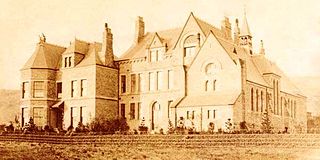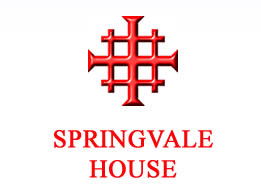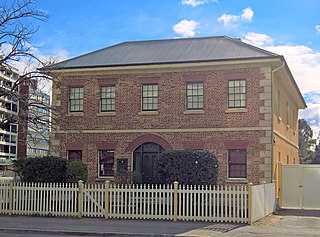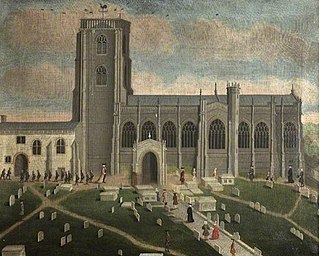
Charterhouse is a public school in Godalming, Surrey, England. Originally founded by Thomas Sutton in 1611 on the site of the old Carthusian monastery in Charterhouse Square, Smithfield, London, it educates over 800 pupils, aged 13 to 18 years. Charterhouse is one of the original nine English public schools reported upon by the Clarendon Commission in 1864 leading to its regulation by the Public Schools Act 1868.

Clifton College is a public school in the city of Bristol in South West England, founded in 1862 and offering both boarding and day school for pupils aged 13–18. In its early years, unlike most contemporary public schools, it emphasised science rather than classics in the curriculum, and was less concerned with social elitism, e.g. by admitting day-boys on equal terms and providing a dedicated boarding house for Jewish boys, called Polack's House. Having linked its General Studies classes with Badminton School, it admitted girls to every year group in 1987 and was the first of the traditional, boys, public schools to become fully coeducational. Polack's House closed in 2005 but a scholarship fund open to Jewish candidates still exists. Clifton College is one of the original 26 English public schools as defined by the Public Schools Yearbook of 1889.

Oakham School is a public school in Oakham, Rutland, England.

The College of Richard Collyer, formerly called Collyer's School, is a co-educational sixth form college in Horsham, West Sussex, England. The college was rated as being 'good' by Ofsted in 2021.

Windermere School is an independent, coeducational boarding and day school in the English Lake District. Founded in 1863, it has approximately 360 pupils between the ages of 3 and 18, around a third of whom are boarders. The School is split across three campuses on over fifty acres of land: the junior school at Elleray; the senior school and sixth form at Browhead; and Hodge Howe, the school's Royal Yachting Association watersports centre on the shores of Lake Windermere.

Hutton Grammar School is an 11–18 boys voluntary aided, state-funded Church of England comprehensive day school. It is located 3 miles (4.8 km) south west of Preston, Lancashire, in Hutton, England. It provides education for boys from the age of 11 to 16, and in the Sixth Form for both boys and girls.
Kent College, Canterbury is a co-educational private school for boarding and day pupils between the ages of 3 months and 18 years. It was founded in 1885, and is a member of the Headmasters' and Headmistresses' Conference. Originally established as a boys' public school, it admitted girls into the sixth form in 1973 and since 1975 it has been fully co-educational.
St Boniface's Catholic College is a secondary school for boys, under the direction and trustees of the Roman Catholic Community in the Plymouth area in the South West of England. Founded in 1856 as an independent boarding and day school for "young Catholic gentlemen" in the West Country, it is now a comprehensive school. The College is named for St Boniface who was born in Crediton, Devon and is the patron saint of Germany. The school has a list of distinguished former pupils including Air Chief Marshal Sir John Gingell GBE KCB KCVO, the writer and intelligence agent Alexander Wilson, and Sir Julian Priestley KCMG, Secretary General of the European Parliament from 1997 to 2007.

Founded in 1675, Buxton College was a boys' Public School and, from 1923, a grammar school in Buxton, Derbyshire whose site has been expanded since 1990 to be used as the fully co-educational comprehensive Buxton Community School.
Jeppe High School for Girls is a public English medium high school for girls situated in the suburb of Kensington in Johannesburg in the Gauteng province of South Africa, The school's address is 160 Roberts Ave, Kensington, Johannesburg, 2094, South Africa. The school boasted a 100% matric pass rate in 2014. It was once part of the oldest public school in Johannesburg, Jeppe High School for Boys until 1919, when a separate premises for the girls was built.

The British Schools Museum is an educational museum based in original Edwardian and Victorian school buildings in Hitchin in Hertfordshire, England. The museum complex is made up of Grade II listed school buildings housing infants, girls and boys schools with houses for Master and Mistress. It includes a monitorial schoolroom based on the educational theories of Joseph Lancaster for 300 boys, which opened in 1837, and a rare galleried classroom, dating from 1853.

Hazelwood School is a private preparatory school in Limpsfield, Surrey, England.

The Lodge School is a co-educational government secondary school in Saint John, Barbados, established in 1745. The school has closed and reopened four times, and has been known as Codrington College, The College, The Mansion School, the Codrington Grammar School, The Codrington Foundation School, Codrington Collegiate School, Codrington Endowed School, Codrington Lodge Grammar School and The Lodge Collegiate School. By 1882 the school's name had finally settled on The Lodge School, after the Chaplain's Lodge where some of the early classes were undertaken.

Nantwich Grammar School, later known as Nantwich and Acton Grammar School, is a former grammar school for girls and boys in Nantwich, Cheshire, England. It now forms part of the mixed comprehensive school, Malbank School and Sixth Form College.

Marlborough Royal Free Grammar School, previously known as Marlborough Grammar School and King Edward's School, Marlborough, was a grammar school in the town of Marlborough, in Wiltshire, England, founded in 1550.

Springvale House Preparatory School is an independent, preparatory, boarding and day school in Mashonaland East, Zimbabwe that was established in 1952. The school shares facilities with Peterhouse Girls' School on the Springvale Estate of approximately 1,200 acres (490 ha) with Gosho Park, a conservation area on the estate, being adjacent to the two schools. The majority of the pupil population are boarders while the remainder are day scholars.

Lincoln Grammar School or Lincoln Free School was formed as the result of the amalgamation of the Lincoln City Free School and the Lincoln Chapter Grammar School. The amalgamation occurred in January 1584, but the two schools may have been effectively working as single school from 1560. In 1574 Lincoln City Corporation had reached an agreement with Robert Monson who was donating the Greyfriars for use as a Grammar School. This was to replace an older City Free school, which had been in scholegate. The exact location of this Free school is uncertain, but scholegate probably refers to Danesgate, but other evidence suggests that the earlier school was close to St Rumbold's church.

Harrisford is a heritage-listed former residence, school building, factory and workshop at 182 George Street, Parramatta, City of Parramatta, Sydney, New South Wales, Australia. It was built between 1823 and 1829. The property is owned by The Kings School Old Boys Union. It was added to the New South Wales State Heritage Register on 2 April 1999.

Yeovil Grammar School was a grammar school in Yeovil, Somerset, which was founded or refounded about 1860 and closed in 1906 when its only headmaster, Henry Monk, retired.
















